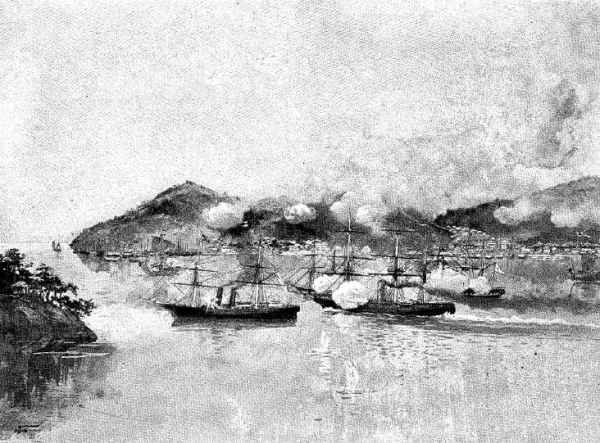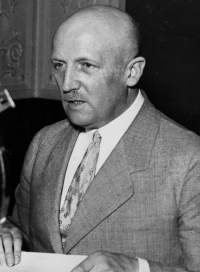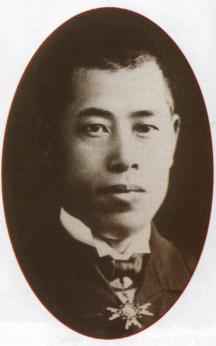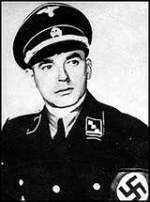
April 4

1854 China (April 4–June 17): A combined US-GB naval force invade Shanghai, China, to protect their respective interests. Subsequent US military interventions or incidents in China: 1855, 1856, 1859, 1866, 1894–1895, 1898–1899, 1900, 1911, and 1912–1941.
1882 Birth: Kurt von Schleicher:

German army officer and last chancellor of the Weimar Republic. A career army officer, he rose to major general by 1929 and became a key figure in the Weimar Republic. His political intrigues helped secure for him the posts of defense minister (1932) and chancellor (1932-33). Seeking to keep the Nazis under the army's control, he offered to participate in a government with Adolf Hitler, but Hitler refused him and thereafter regarded Schleicher as his chief enemy. Dismissed by Paul von Hindenburg in favor of Adolf Hitler, Schleicher was murdered during the Night of the Long Knives [1934].
1884 Birth: Isoroku Yamamoto:

Isoroku Yamamoto was born on April 4, 1884, in Nagoka, Japan, the last of seven children. His first name "Isoroku" translates into the number "56", which was his father's age when he was born. He lived near Nagaoka, entered the Imperial Naval School at age 16, and was an ensign on a cruiser during the Battle of Tshushima on May 27, 1905, during the Russo-Japanese war, in which he lost two fingers on his left hand. He was adopted by the Yamamoto family and took their name. He was promoted to commander and transferred to Tokyo naval headquarters, and soon afterwards he married. He traveled to the US to study economics at Harvard and to also learn about petroleum . . . . In 1923 he was appointed head of the air training base at Kasumiguara and became a naval attaché in Washington, DC. He returned to Japan a few years later and became Vice-Minister of the Navy. Favoring air power as a basis for war, Yamamoto championed new aircraft carriers for Japan's navy but opposed the Tripartite Pact of 1939, which formed an alliance among militarist Japan, Nazi Germany, and fascist Italy.
In August 1939 he was promoted to full admiral and became the commander-in-chief of Japan's Combined Naval Fleet. He did not wish to go to war with the US, knowing well the full industrial might and will of the Americans, who he believed would prevail in a war against Japan if only by attrition. However, once the military leaders decided on a war, Yamamoto devoted himself, albeit reluctantly, to the task of giving Japan the upper hand by masterminding the attack on Pearl Harbor in December 1941, which officially brought both Japan and the US into World War II. Having seen the Japanese defeat in the Battle of Midway in 1942, Yamamoto knew that Japan's chance of winning the war was lost.
In 1943 he toured the Solomon Islands during the Battle of Guadalcanal, and took over naval operations. On April 18, 1943, American intelligence, which had been tracking Yamamoto's movements and looking for an opportunity to eliminate him, discovered that he was in a plane flying near the island of Bougainville. A squadron of fighters was quickly dispatched to intercept it, with orders to shoot it down at all costs. The fighters swarmed over Yamamoto's aircraft, and it was soon shot out of the sky, crashing in flames on the island and killing all aboard, including Yamamoto. He was 59 years old.
[See: Countdown to Infamy: Timeline to Pearl Harbor.]1916 World War I: Gefreiter Adolf Hitler endures trench warfare in Flanders (Artois) with 3 Company, 16 Reserve Infantry Regiment [List Regiment]. [For further details, Click here.]
1917 World War I: Various: The US Senate 1917 List Regiment: Gefreiter Adolf Hitler's 16 Reserve Infantry Regiment [] , 3 Company, fortify trenches near Arras. [For further details, Click here.] 1918 World War I: Various:
Second Battle of the Somme:
On March 21, 1918, a major offensive against Allied positions in the Somme River region of France began with five hours of bombardment from more than 9,000 pieces of German artillery. The poorly prepared British Fifth Army was rapidly overwhelmed and forced into retreat. For a week, the Germans pushed toward Paris, shelling the city from a distance of 80 miles with their "Big Bertha" cannons. However, the poorly supplied German troops soon became exhausted, and the Allies halted the German advance as French artillery knocked out the German guns besieging Paris. On April 2, U.S. General John J. Pershing sent American troops down into the trenches to help defend Paris and repulse the German offensive. It was the first major deployment of U.S. troops in World War I. Several thousand American troops fought alongside the British and French in the Second Battle of Somme.
By the time the Somme offensive ended on April 4, the Germans had advanced almost 40 miles, inflicted some 200,000 casualties, and captured 70,000 prisoners and more than 1,000 Allied guns. However, the Germans suffered nearly as many casualties as their enemies and lacked the fresh reserves and supply boost the Allies enjoyed following the American entrance into the fighting. (History.com)
Gefreiter Adolf Hitler's 16th RIR constructs fortified works in difficult defensive positions on an active front with German assault regiments near Fountaine (Montdidier). [For further details, Click here.] 1919 Various:
Weimar: Max Hofweber The Jewish Chronicle in London states: "The conceptions of Bolshevism are in harmony in most points with the ideas of Judaism." Soon afterward, Victor Marsden the London Morning Post's reporter in Russia will write that 477 of the leading 545 Bolshevik officials are Jews. Once again, conservatives and anti-Semites used these words to stir up anti-Jewish sentiments. [See: When Did Hitler Become an Anti-Semite?]
1933 Various:
Church and Reich: Holocaust: Robert Weltsch publishes an article in the Juedische Rundschau (Jewish Review) under the banner headline, "Wear the Yellow Star with Pride," in reaction to the Nazi boycott of Jewish businesses in Germany. (THP)
USA: Dirigible crashes in New Jersey—killing 73 people in one of the first air disasters in history. The Akron was the largest airship built in the United States when it took its first flight in August 1931. In its short life of less than two years, it was involved in two fatal accidents. [For further details, Click here]
1934 Various:
Holocaust: Romania: The three Legionaries (Iron Guardsmen) who assassinated Prime Minister Ion Duca are given life sentences.
1939 Iraq: Faisal II becomes King.
1941 World War II: Various:
North Africa: Prisoners: France: From two letters addressed to the German Armistice Commission at Wiesbaden by the ex-Ambassador Scapini, 4 April 1941. M. Georges Scapini, Ambassador of France. To his Excellency Monsieur Abetz, German Ambassador in Paris. Subject: Men captured after the coming into force of the Armistice Convention and treated as prisoners of war. I. The Geneva Convention applies only during a state of war as far as captures are concerned. Armistice, however, suspends war operations; therefore, any man captured after the Armistice Convention came into force and treated as a prisoner of war, is wrongfully retained in captivity . . . . The Armistice Convention, in its second paragraph, states only that the French Armed Forces stationed in regions to be occupied by Germany are to be brought back quickly into unoccupied territory and demobilized, but does not say that they are to be taken into captivity, which would be contrary to the Geneva Convention . . . . T. Soldiers. As such I would define, by convention, men who, though freed after the armistice, could not for some reason due to the difficult circumstances of that period-be provided with the regular demobilization papers. Many of them were captured and taken into captivity under the same condition as those mentioned above . . . . 1943 World War II: North Africa: Eisenhower's US First Army joins Montgomery's Eighth Army near Gafsa.
1944 Various:
Holocaust: Auschwitz: World War II: Ethiopia: British troops capture Addis Ababa.
1945 World War II: Various:
Hungary Again a mass of new decrees and orders pour in from Bormann. Bormann [above] has made a paper chancellery out of the Party Chancellery. Every day he sends out a mountain of letters and files which Gauleiter at present in the midst of the struggle can in practice not even read. In part, it's a matter of completely useless stuff of no value for the practical struggle. (Kershaw)
Okinawa: US troops encounter first significant resistance from Japanese forces.
Germany: The city of Kassel is taken by troops from Patton's Third Army. [See: The Last Days of the Third Reich.]
Holocaust: Ohrdruf: American troops discover mass graves:
The Ohrdruf camp was a subcamp of the Buchenwald concentration camp, and the first Nazi camp liberated by U.S. troops. Created in November 1944 near the town of Gotha, Germany, Ohrdruf supplied forced labor in the form of concentration camp prisoners for railway construction leading to a proposed communications center, which was never completed due to the rapid American advance. In late March 1945, the camp had a prisoner population of some 11,700, but in early April the SS evacuated almost all the prisoners on death marches to Buchenwald. The SS guards killed many of the remaining prisoners who were too ill to walk to the railcars. When the soldiers of the 4th Armored Division entered the camp, they discovered piles of bodies, some covered with lime, and others partially incinerated on pyres. The ghastly nature of their discovery led General Dwight D. Eisenhower, Supreme Commander of the Allied Forces in Europe, to visit the camp on April 12, with Generals George S. Patton and Omar Bradley. After his visit, Eisenhower cabled General George C. Marshall, the head of the Joint Chiefs of Staff in Washington, describing his trip to Ohrdruf: "The most interesting‑-although horrible‑-sight that I encountered during the trip was a visit to a German internment camp near Gotha. The things I saw beggar description. While I was touring the camp I encountered three men who had been inmates and by one ruse or another had made their escape. I interviewed them through an interpreter. The visual evidence and the verbal testimony of starvation, cruelty and bestiality were so overpowering as to leave me a bit sick. In one room, where they were piled up twenty or thirty naked men, killed by starvation, George Patton would not even enter. He said that he would get sick if he did so. I made the visit deliberately, in order to be in a position to give first-hand evidence of these things if ever, in the future, there develops a tendency to charge these allegations merely to propaganda."
1946 Serial Killer: Dr Marcelle Petiot is sentenced to death in Paris, for murdering by injection 27 people whom he had told he was a Resistance member helping them flee Nazi-occupied France.
1949 Cold War: NATO pact signed:
The United States and 11 other nations establish the North Atlantic Treaty Organization (NATO), a mutual defense pact aimed at containing possible Soviet aggression against Western Europe. NATO stood as the main U.S.-led military alliance against the Soviet Union throughout the duration of the Cold War. [For further details, Click here]
1960 Death: Alfred Naujocks: At 8.00 on the evening of 31 August 1939, a team of six SS agents stormed a radio station in the German town of Gleiwitz, close to the Polish border. They were led by Alfred Naujocks: a Sturmbannfuehrer in the SS, and an agent of the SS intelligence corps; the Sicherheitsdienst (SD). He and his men fired a few shots and handcuffed the startled station personnel. One of them then broadcast a stirring speech in Polish, full of anti-German rhetoric, calling on the Poles to rise up against their historic enemy: 'The hour of freedom has arrived', he concluded, 'Long Live Poland!' Outside, meanwhile, a truckload of concentration camp inmates had been delivered. Drugged but alive, they were dressed in Polish uniforms, strategically arranged around the site, and then machine-gunned. The world awoke to the astonishing news that Poland had launched an unprovoked attack on Hitler's Germany, and that German forces were 'returning fire'. The Second World War had begun. [For further details, Click here]
1970 Hitler remains: Soviet leader Leonid Brezhnev orders the bodies of Hitler and his entourage exhumed from their hiding place at Magdeburg, and incinerated. In a move personally approved by Leonid Brezhnev, then the Soviet leader, Andropov gave the order to dig up the remains and destroy them for fear that they would one day be discovered and the site turned into a shrine to Hitler. The KGB first secured the area around the Magdeburg camp to guard against curious neighbors. A small tent was erected over the grave and five officers dug through the night, first with pickaxes, then with shovels. They found five cases containing the remains of ten bodies. After counting the leg bones to ensure that no body was missing, they loaded the cases onto a lorry and drove them to a nearby training camp, where they were burnt. Skull fragments, including his jawbone, are all that remain of Hitler. They were sent in secret to Moscow in 1945, together with parts of a blood-soaked leather couch on which the Fuehrer is believed to have died. Blood from the couch matched Hitler's blood type and the skull was painstakingly reconstructed except for a missing cheekbone and other fragments destroyed when his corpse was doused in petrol and set alight by an aide. After months of research, based mainly on the dictator's teeth, the Russians concluded the remains were indeed Hitler's. "We concluded that first Hitler took an ampoule of poison and then shot himself," said Kondrashev. "He was then burnt and buried, first by the Nazis and then by the Russians." The skull is still in the hands of the FSB, the KGB's successor organisation, and is believed to be held in an archive on the outskirts of Moscow. According to the latest reports, it is stored in a small cardboard box originally used for ballpoint pen refills. [See: Did Adolf Hitler Really Commit Suicide?]
Edited by Levi Bookin (Copy editor) Click to join 3rdReichStudies Please note that the list-owner and the moderator are not responsible for, and do not necessarily approve of, the random ads placed on our pages by our web server. They are, unfortunately, the price one pays for a 'free' website. FAIR USE NOTICE: This site may contain copyrighted material the use of which has not always been specifically authorized by the copyright owner. We are making such material available in our efforts to advance understanding of historical, political, human rights, economic, democracy, scientific, environmental, and social justice issues, etc. We believe this constitutes a 'fair use' of any such copyrighted material as provided for in section 107 of the US Copyright Law. In accordance with Title 17 U.S.C. Section 107, the material on this site is distributed without profit to those who have expressed a prior interest in receiving the included information for research and educational purposes. If you wish to use copyrighted material from this site for purposes of your own that go beyond 'fair use', you must obtain permission from the copyright owner.
1. Civilians. If it is admitted that civilians captured before the armistice cannot be treated as prisoners of war, as discussed in my previous letter, surely there is all the more reason not to consider as such those captured after the armistice. I note in this respect that captures, some of which were collective, were carried out several months after the end of hostilities . . . . To the categories of civilians defined in my first letter, I wish to add one more-that of demobilized civilians who were going back to their homes in the occupied zone after the armistice and who, more often than not, were captured on their way home and sent into captivity as a result of the initiative of local military authorities . . . .
A. Civilians not subject to military service. It is obvious that these men could not be considered soldiers according to French law. They can be classified, according to age, into three groups:
(a) Men under 21 not yet called to the colors. Example: Flanquart, Alexandre, 18 years old, captured by the German troops at Courrieres, Pas-de-Calais, at the time of the arrival of the latter in that region. His address in captivity was Number 65/388, Stalag II-B.
(b) Men between 21 and 48 who were not mobilized, who were demobilized, or who were considered unfit for service . . . .
(c) Men specially assigned to the army. I will classify them into two groups:
1. Men mobilized into special corps, which are military formations established at the time of the mobilization by different ministerial departments . . . .
2. Men specially assigned, who at mobilization were kept in the positions which they held in time of peace in military services or establishments. Example: Workmen in artillery depots. Civilians specially assigned. Contrary to those mentioned above, the civilians who were specially assigned did not belong to military formations and were not subject to military authority. Nevertheless they were arrested . . . .



levi.bookin@gmail.com







